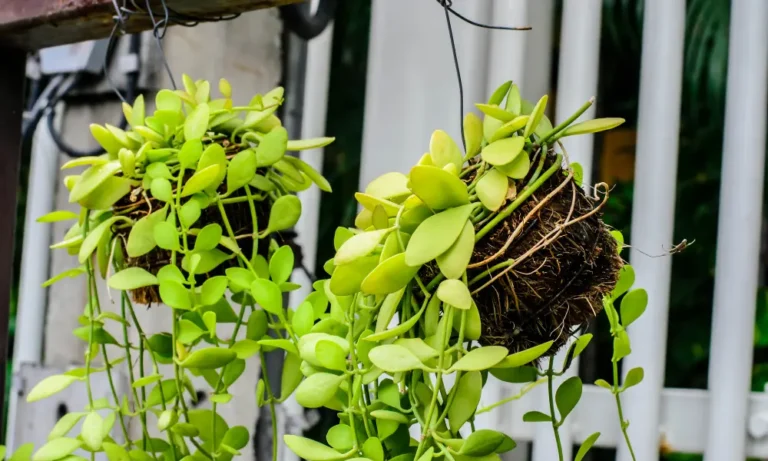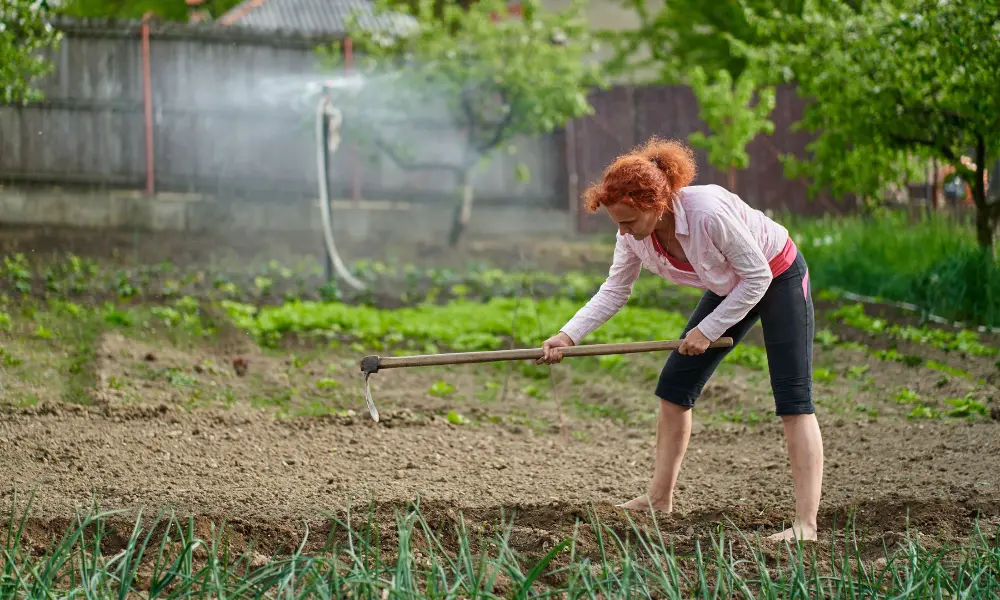Hanging Orchids: When it comes to hanging displays, the Phalaenopsis orchids take the spotlight. Also known as moth orchids, these enigmatic beauties flaunt their large and vibrant flowers for weeks on end.
In a captivating array of hues including white, pink, yellow, and purple, they offer an irresistible allure that effortlessly complements any hanging arrangement. What\’s more, caring for Phalaenopsis orchids is a breeze, making them the perfect choice even for those just starting out.
But let us not forget about another contender in this mesmerizing realm – the Dendrobium orchid. With its long and slender flower spikes gracing a hanging basket with sheer elegance, this species demands attention wherever it resides.
Showcasing an enchanting palette spanning from pristine whites to sunny yellows and even captivating pinks and purples, Dendrobiums thrive under bright yet indirect light conditions while reveling in slightly cooler temperatures. Consequently, they become the epitome of excellence when it comes to hanging displays within areas blessed by moderate climates.
Should you choose to embark on the journey of nurturing these splendid beings properly, be prepared for multiple blooming seasons throughout each year – infusing every corner with bursts of vivacious color that can only be described as magical.
Understanding the Ideal Growing Conditions for Hanging Orchids
Orchids, with their delicate and enchanting beauty, have captured the hearts of many as a favored choice for hanging displays. However, unlocking the secrets to their optimal growth and well-being requires an understanding of the elusive ideal conditions in which these captivating flowers thrive.
In this perplexing world of orchid care, one must first acknowledge the significance of adequate lighting. These ethereal beings are known to flourish under the gentle embrace of bright yet indirect light. A strategic placement near a window facing north or east emerges as an exceptional decision; it grants them access to just the right amount of sunlight while safeguarding against brutal direct rays that could wreak havoc on their fragile petals.
Furthermore, vigilance is necessary when choosing their habitat – extreme temperature fluctuations or drafts pose unyielding threats that can stifle their growth. The nurturing environment should maintain an equilibrium within a temperature range spanning from 60-80°F (15-27°C). By adhering to these peculiar requirements regarding illumination and climate alike, your cherished orchids will be bestowed with firm foundations upon which they may flourish and burst forth into resplendent blooms.
Choosing the Right Potting Medium for Hanging Orchids
When faced with the perplexing task of selecting a suitable potting medium for hanging orchids, one must delve into their unique requirements. Orchids, these enigmatic tropical plants, thrive in environments abundant with brisk air circulation and copious humidity. Consequently, it is imperative to procure a potting medium that can both facilitate proper drainage and retain essential moisture.
Among the myriad options available for hanging orchids lies an intriguing mix consisting of bark, sphagnum moss, and perlite. This harmonious blend grants unparalleled airflow and impeccable drainage capabilities, shielding delicate roots from succumbing to waterlogged perils.
The bark imparts stability while granting the orchid a secure foothold; meanwhile, the sphagnum moss diligently holds onto precious moisture. On the other hand, perlite assumes its role as guardian of loose soil structure and optimal oxygenation levels within this medium\’s realm. Such an amalgamation proves eminently suitable for various orchid types but particularly beneficial for those partial to drier climes.
Alternatively beckoning horticultural enthusiasts is yet another captivating option: a concoction comprising coconut husk chips, perlite, and charcoal. This particular assemblage bequeaths upon our verdant friends a lightweight haven teeming with superior drainage properties.
The coconut husk chips display an impressive penchant for absorption—preserving coveted moisture whilst deftly ushering excess fluids away from vulnerable roots through their porous framework. Perlite dutifully preserves aerated conditions that discourage compaction—a vital prerequisite paving the way towards robust root growth!
Lastly but certainly not least is charcoal—an unsung hero purging impurities from this botanical abode whilst upholding equilibrium within its pH parameters. Orchids harboring proclivities toward lofty humidity levels or basking in tropical realms shall find solace in this remarkable composition.
Thus concludes our exploration into two alluring possibilities awaiting those tasked with finding fitting homes for dangling orchids. May these words of guidance prove a beacon amidst the labyrinthine world of potting mediums, preserving both their essence and authorial tone intact.
Essential Steps for Properly Mounting Orchids for Hanging
Adding a touch of elegance and allure to your humble abode or lush garden, hanging orchids possess an ethereal charm. However, the art of mounting these delicate beauties demands meticulous attention to ensure their well-being and enduring splendor. Embarking on this journey entails a series of indispensable steps that must be carefully adhered to.
Foremost, selecting an appropriate medium for mounting is paramount. The discerning aficionado often gravitates towards cork, tree fern fiber, or wooden plaques as they bestow stability and a nurturing habitat for the precious roots.
Prudence dictates verifying the cleanliness of the chosen material, devoid of any nefarious chemicals or insidious toxins capable of inflicting harm upon the treasured orchid. Once the selection is finalized with unwavering resolve, immersing it in water becomes imperative; granting it respite from dehydration while simultaneously purging undesirable debris from its surfaces.
It is judicious to avoid employing materials prone to retaining excessive moisture as such folly may pave a path toward root decay and impede its flourishing existence.
How to Water and Fertilize Hanging Orchids for Optimal Growth
Properly nourishing and drenching hanging orchids with water is absolutely vital for their utmost flourishing. These delicate flora demand a meticulous equilibrium of moisture and nutrients in order to thrive within their suspended realm.
When it comes down to hydrating these dangling orchids, one must bear in mind that their requirements differ from those grown in traditional pots. Given their exposed disposition, these orchids often desiccate at an accelerated rate and may need more frequent irrigation. Nevertheless, it is crucial to refrain from excessive watering as surplus dampness can give rise to root decay and various predicaments.
It is highly recommended to employ the \”soak and dry\” approach, wherein the orchid is completely immersed in water before being left to parch prior to subsequent watering sessions.
This tactic emulates their natural habitat where rain saturates them momentarily followed by a period of aridity. Consistently examining the humidity levels within the potting medium while adjusting watering intervals accordingly will undoubtedly guarantee the well-being of your hanging orchids.\\n
Pruning and Repotting Techniques for Maintaining Healthy Hanging Orchids
Pruning, an indispensable task for the well-being of hanging orchids, bewilders and captivates with its perplexing effects. Its regular implementation bewitches by fostering improved air circulation and averting the emergence of dense foliage, a breeding ground for heightened humidity and the unwelcome growth of mold or fungi.
A skillful pruner must judiciously eliminate any discolored or lifeless leaves and spent flower spikes. This not only enhances the plant\’s aesthetic allure but also redirects its vital energy towards fresh growth and blooming.
Repotting, another integral technique to ensure optimal health for these ethereal beauties, astonishes with its burstiness as it intricately interweaves roots within their pots. In doing so, they succumb to inadequate drainage capabilities and limited access to nourishing sustenance.
When embarking on this transformative process, one must exercise utmost care in selecting a pot adorned with ample drainage holes and an appropriate potting medium akin to a melange of orchid bark, sphagnum moss, and perlite. With gentle hands, extract the orchid from its current abode while delicately trimming any deceased or damaged roots before nestling it into its new dwelling ensconced in revitalizing potting material.
Repotting should be undertaken every one to two years or when these enchanting beings outgrow their existing abodes. Adhering steadfastly to these enigmatic pruning rituals alongside repotting techniques will bestow upon us flourishing hanging orchids that shall endure through time itself
Common Pests and Diseases That Affect Hanging Orchids and How to Prevent Them
Orchids, with their exquisite and enigmatic allure, are susceptible to an assortment of pests and ailments that can have a detrimental effect on their growth and overall vitality. Among these vexing adversaries is the spider mite, a minuscule creature capable of wreaking havoc upon hanging orchids. These diminutive insects possess a remarkable ability to swiftly propagate throughout your collection, siphoning the very life force from leaves and stems alike.
In order to stave off the insidious threat of spider mite infestations, it is imperative to diligently scrutinize your orchids for any telltale signs of these pernicious intruders. Should you discover such an unwelcome presence, promptly isolate the afflicted plant without hesitation and administer an appropriate insecticide as treatment.
Another formidable foe that poses peril to dangling orchids is none other than the mealybug. Cloaked in a shroud reminiscent of cottony wisps, these voracious critters possess an uncanny capacity for rapid multiplication while simultaneously feasting upon the precious sap within the plant\’s delicate anatomy.
To shield against incursions by mealybugs, one must uphold impeccable standards of hygiene whilst consistently monitoring one\’s cherished orchid specimens for any indications of these nefarious nuisances. Upon sighting these troublesome creatures, manually extricate them utilizing a cotton swab steeped in rubbing alcohol or employ a systemic insecticide as an effective means of eradication. Furthermore, employing a slender veneer of insecticidal soap upon leaf surfaces may serve as deterrent against their relentless advances.
Tips for Creating Stunning Hanging Orchid Displays in Your Home or Garden
Engaging in the art of crafting breathtaking hanging orchid displays within the confines of your abode or outdoor sanctuary has the power to infuse an air of refinement and exquisiteness into any given space. Regardless of whether you possess a vast balcony or a modest nook nestled within your living quarters, the introduction of suspended orchids possesses an uncanny ability to metamorphose said area into a veritable verdant haven.
One nugget of wisdom for constructing such awe-inspiring arrangements lies in handpicking an array of orchids that boast distinct hues and varying dimensions. By doing so, one not only introduces a visual allure but also produces a lively and captivating composition that is sure to arrest attention.
Another kernel worth considering is the meticulous selection process pertaining to containers designated for housing these splendid hanging orchids. Opting for pots or baskets equipped with commendable drainage capabilities acts as an effective deterrent against unwelcome accumulation of water, subsequently safeguarding against pernicious root rot. Furthermore, it becomes imperative that these hanging vessels exhibit commendable robustness, capable enough to bear the burden imposed by these graceful floral wonders.
The discerning individual may take delight in exploring diverse materials available at their disposal ranging from terracotta options all through plastic alternatives even spanning across woven baskets which imbue proceedings with an organic charm certain to attract admiration.
What\’s more? It behooves us not overlook container size considerations – ensuring perfect harmony between vessel proportions and intended botanical occupants serves as both catalyst for appropriate flourishing whilst simultaneously mitigating overcrowding tendencies rampant among haphazard endeavors.
Orchid Care Mistakes to Avoid When Hanging Orchids
Many individuals fall into the trap of excessively watering their suspended orchids, believing that a continuous supply of moisture is essential. However, it should be noted that orchids are epiphytic flora, which signifies their inherent inclination to perch on trees and derive sustenance from the atmosphere\’s nutrients and moisture.
The consequences of overwatering can be dire, leading to root decay and ultimately spelling doom for these exquisite plants. Therefore, it becomes imperative to allow intervals between waterings for the roots to desiccate entirely before replenishing their liquid provisions.
Another frequent blunder in caring for hanging orchids is underestimating the significance of sufficient illumination. While these splendid blossoms thrive in radiant yet indirect luminosity, they possess an admirable tolerance towards modest doses of direct sunlight as well.
Placing your cherished orchid in an inadequately illuminated area will unquestionably result in stunted growth, dearth of blooms, and an overall regression in its condition. Striking a harmonious balance between providing ample light without subjecting it directly to scorching sun rays becomes absolutely indispensable since excessive heat can also inflict harm upon these delicate beings.
Inspiring Ideas for Incorporating Hanging Orchids into Your Décor or Landscape
Introducing hanging orchids into your environment, whether it be indoors or outdoors, can infuse an air of sophistication and aesthetic splendor. An idea that is sure to captivate is the creation of a resplendent hanging orchid chandelier. By utilizing a diverse range of orchid species boasting various hues and statures, you can fashion a visually arresting exhibition.
Suspend these magnificent blooms at varying lengths from a robust fixture, such as an enduring metal hoop or an exquisite chandelier frame, allowing them to gracefully tumble downwards in cascading grandeur. This exceptional centerpiece will undoubtedly seize attention and ignite lively conversations within any room.
An alternative avenue for incorporating hanging orchids resides in the realm of crafting a miniature yet enchanting orchid garden. Procure an ornamental hanging basket that boasts multiple tiers or compartments for optimal elegance. Select an assortment of captivating orchids and meticulously plant them within designated sections, ensuring balance and aesthetically pleasing arrangements are achieved with utmost care.
Dangle this petite haven for orchids in well-illuminated surroundings like sun-drenched windowsills or serene patios, basking in the flourishing growth and blossoming beauty that ensues. Such an arrangement bestows upon any space a touch of natural charm while affording you the pleasure to revel in the delicate allure exhibited by myriad species harmoniously coexisting within one compact tableau
What types of orchids are perfect for hanging displays?
Ah, the realm of hanging orchids is vast and diverse. Phalaenopsis, Dendrobium, and Oncidium are among the enchanting varieties that lend themselves gracefully to suspended exhibitions. Their long stems arch with elegance, their blooms delicately sway in a captivating dance.
What are the ideal growing conditions for hanging orchids?
The quest for optimal growth in hanging orchids unveils a puzzle. These ethereal beings yearn for bright yet indirect light, seeking sheltered spots where filtered sunlight gently caresses their leaves. Warmth between 65-85°F (18-29°C) becomes their sanctuary; they thrive amidst high humidity levels of approximately 50-70%.
How do I choose the right potting medium for hanging orchids?
In this enigmatic world of mounting these aerial wonders, selecting an appropriate potting medium unravels secrets whispered by seasoned gardeners. A loose and well-draining composition beckons—perhaps a blend of bark, sphagnum moss, and perlite? This concoction breathes life into roots while preventing suffocation caused by waterlogged soils.
What are the essential steps for properly mounting orchids for hanging?
To embark on this journey of suspending nature\’s jewels requires careful orchestration—a harmonious dance between mount and plant. Seek out driftwood or wooden planks as worthy stages upon which your chosen orchid shall perform its delicate ballet. With wire or specialized clips as your allies, secure the precious darling onto its throne with precision and grace.
How should I water and fertilize hanging orchids for optimal growth?
Watering these celestial creatures demands mastery over subtlety—an artful balance between saturation and restraint must be achieved. Thusly soaks must be thorough but not excessive; ensure the potting medium is drenched and then allow it to drain completely, granting roots a moment of respite. As for nourishment, diluted orchid fertilizers applied biweekly during growth seasons shall be their sustenance.
What are the pruning and repotting techniques for maintaining healthy hanging orchids?
To maintain vitality within these suspended beauties necessitates careful stewardship. Pruning away withered or yellowing leaves and stems becomes an act of devotion—eliminating decay to make room for rejuvenation. Repotting rituals beckon every one to two years or when decomposition consumes the existing medium. Gently release your precious charge from its mount, trim deceased roots, embrace fresh potting soil in a new vessel.
What are some common pests and diseases that affect hanging orchids and how can I prevent them?
Ah, the perils that lurk amidst this ethereal realm! Aphids, scale insects, mealybugs—these treacherous foes seek refuge upon delicate petals and tender foliage. Thwart their advances through vigilant inspection; detect early signs of infestation with utmost attentiveness. Swift action may require insecticidal soap or neem oil as weapons against these insidious invaders. Beware also fungal infections that loom ominously—a well-ventilated environment coupled with judicious watering shall ward off their sinister intentions.
What are some tips for creating stunning hanging orchid displays in my home or garden?
To craft captivating spectacles that tantalize both sight and soul requires audacity of imagination intertwined with horticultural acumen. Unite different species bearing complementary hues; let their diverse growth habits harmoniously coexist amidst a symphony of colors. Varying heights add layers of intrigue while decorative hooks or macramé hangers elevate aesthetics further still. The incorporation of moss or twigs bestows an ethereal touch upon your suspended sanctuary—exult in the breathtaking beauty of your hanging orchid display.
What are some orchid care mistakes to avoid when hanging orchids?
Beware, intrepid caretaker, for treacherous pitfalls await those who falter on this path. Overwatering shall bring ruin upon your delicate charges; allow the potting medium to breathe and recover between watering rituals. Adequate light becomes a lifeline for these ethereal beings—ensure they bask in the embrace of bright yet indirect illumination. And banish thoughts of excessively large pots from your virtuous intentions—for water retention and inadequate drainage shall be their undoing.
Can you provide some inspiring ideas for incorporating hanging orchids into my décor or landscape?
Indulge in visions that dance with delight within the garden of possibilities! Hang them en masse from pergolas or trellises—a celestial congregation poised to enchant all who behold its splendor. Indoors, conjure an otherworldly chandelier adorned with these ethereal blossoms—the epitome of sophistication and grace.
Suspended within glass terrariums or orbs, they transform into captivating gems gleaming amidst enchanted spheres. Vertical gardens host cascades of resplendent petals while wall-mounted planters cascade forth like fountains overflowing with nature\’s exquisite bounty. Let your creativity soar as you weave tales where hanging orchids become protagonists in a symphony celebrating life\’s wondrous tapestry.
Conclusion
In the world of gardening and floral elegance, few plants command attention quite like hanging orchids. These ethereal blooms are a testament to nature’s artistry and can elevate any garden, patio, or indoor space with their enchanting beauty. In this guide, we’ll delve into the captivating realm of hanging orchids, exploring their various types, care tips, and creative display ideas.
Hanging orchids encompass a diverse group of orchid species renowned for their gracefully cascading tendrils and stunning blossoms. Here are some notable varieties to consider:
Phalaenopsis orchids, also known as “moth orchids,” are renowned for their elegant, arching stems laden with vibrant, long-lasting flowers. Their enchanting appearance makes them a top choice for hanging displays.
Cymbidium orchids are prized for their robust growth and striking blooms that dangle gracefully from sturdy stems. They come in an array of colors and patterns, adding a touch of sophistication to any setting.
Dendrobium orchids are celebrated for their pendulous canes, adorned with clusters of exquisite blossoms. These orchids thrive in bright, indirect light and can be a stunning addition to your hanging garden.
Caring for hanging orchids requires a gentle touch and a few essential guidelines:
Ensure your hanging orchids receive bright, indirect light. Avoid exposing them to harsh, direct sunlight, as it can scorch their delicate leaves and flowers. Orchids typically thrive in temperatures between 60°F to 80°F (15°C to 27°C).
Water your hanging orchids sparingly but consistently. Allow the roots to partially dry out between waterings. Overwatering can lead to root rot, while underwatering can cause stress to the plant.
Orchids thrive in environments with moderate humidity. To maintain adequate moisture levels, consider using a humidity tray or a room humidifier. Proper ventilation is also crucial to prevent stagnant air around your orchids.
Plant your hanging orchids in a well-draining orchid mix, such as a blend of bark, sphagnum moss, and perlite. This ensures proper aeration for the roots.
The versatility of hanging orchids allows for imaginative display options:
Suspend your orchids in decorative hanging baskets, allowing their tendrils to gracefully spill over the sides. This creates a breathtaking curtain of blossoms.
Mount orchids on driftwood, cork bark, or wooden plaques. This mimics their natural epiphytic habitat and showcases their elegance.
Create miniature orchid gardens within glass terrariums or orbs, adding a touch of whimsy to your interior decor.
Combine hanging orchids with complementary plants like ferns, bromeliads, or air plants to create captivating living arrangements.
In the realm of gardening, hanging orchids stand as symbols of grace and sophistication. Their pendulous beauty brings an element of wonder to any space, whether suspended in baskets, mounted on walls, or nestled within terrariums. By following proper care practices and experimenting with creative displays, you can transform your garden into a mesmerizing tapestry of hanging orchids that captivates all who behold it.




